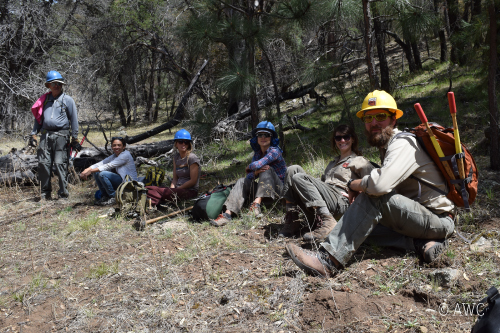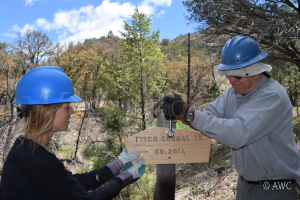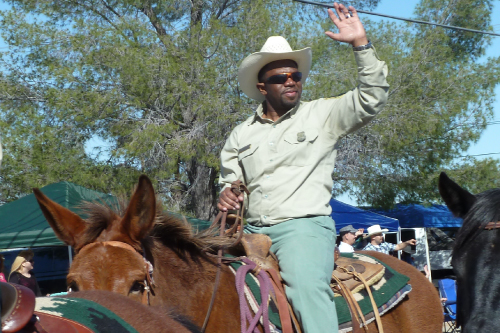|
|
Wildfires and Public Lands: An Interview with Kerwin Dewberry, Coronado National Forest Supervisor
|
June 2016
Kerwin Dewberry is the Supervisor of the Coronado National Forest, which spans nearly 1.8 million acres of Sonoran and Chihuahuan Desert in southeastern Arizona and southwestern New Mexico. The region encompasses grassy savannas and “Sky Island” mountain ranges, and is exceptionally rich in human history and biodiversity. Also very arid, the region is quite vulnerable to wildfire. We spoke with Kerwin recently regarding the important topic of wildfire on public lands.
Tell us about your history and what led you to the Forest Service.
I’ve been with the Forest Service for 21 years; before coming to the Coronado National Forest, I served as Deputy Forest Supervisor of the Tonto National Forest, the major Forest serving the Phoenix metro area. I’ve been in my current position a little less than a year. While in college, I became passionate for natural resources and obtained an internship with the Forest Service as a Soil Scientist. I also worked as a Botanist and a Wildlife Biologist for nine years.
|
What do you particularly want the public to know about expected wildfires on the Coronado National Forest this year?
In responding to wildfires, Life First is one of our guiding concepts. No structure or property is worth risking a life. We will treat each incident individually, and assess risks and potential hazards as we determine what we think the best course of action will be. A primary goal on each fire will be to reduce firefighter exposure to risks and hazards. So in some cases, we might not send firefighters into a certain area.
We will work closely with our partners when responding to incidents, including state and federal agencies, and the valued partners in local and volunteer fire departments. We work side-by-side on incidents of all sizes.
We encourage Forest users to be careful with fire at all times, and to use situational awareness when engaging in activities that could cause a wildfire, like building campfires in safe areas and only leaving them when they are cold to the touch, ensuring tow chains are secured so as not to make contact with roadways, avoiding outdoor welding on windy days, and disposing of smoking materials in ash trays.
Fuels, weather and topography are driving forces of wildland fire. We are experiencing active fire behavior at all elevations, from grasslands to mixed conifer forests. Some fires grow to thousands of acres in a day. So we know the potential for large wildfire growth exists.
|

The Coronado National forest encompasses a
magnificent array of ecological values.
|
What will be your priorities for deploying resources for wildfires?
Safety will be the primary objective on each incident. Efficiency and cost-effectiveness are also important considerations. Additionally, we’ll evaluate the “big picture.” How dry are the fuels, and how heavy are their concentrations? What are the predicted weather conditions? What is the topography, and how accessible is the area? What challenges might we encounter? What is the vegetation type, and the fire history? What are the values at risk? While our policy directs us to suppress all human-caused fires, we also want to recognize the roles that wildland fire plays on our landscapes, many of which evolved with fire.
It may be best in some cases to manage fires for multiple objectives. We may focus our suppression efforts on the parts of the fire that threaten things important to us, like homes or structures and residential areas, ranches, and recreation sites. In more remote areas we may manage the fire to do what it should do naturally, clear the land of excess vegetation and return nutrients to the soil, resulting in revitalized land, and refreshed habitat and rangeland for wildlife and livestock. With lightning-caused fires, which are naturally-occurring ignitions, we might manage the fire to perform its natural role on the land, and take more of an indirect suppression approach, after evaluating the aforementioned factors.
|

AWC volunteer crew that recently worked in the Chiricahua Wilderness to remediate effects of the Horsehoe II fire.
|
Are there any common public misunderstandings about wildfire on Forest lands that you’d like to clear up?
Yes.
Many of our landscapes have evolved with fire. Historically, frequent, low-intensity fires burned across the land, generally staying close to the ground, removing excess fuel and maintaining more open lands. Fire is nature’s great recycler, and can have a cleansing effect, removing old, declining and dead vegetation and returning nutrients to the soil, to be utilized by plants that regenerate following the fire. After a century of fire suppression, vegetation is excessive in many areas due to the absence of fire. Fire behavior is different in many vegetation types. We are fortunate to have the opportunity to use fire as what has been called the “disturbance agent of choice,” to reduce excessive vegetation and lessen the threat of catastrophic wildfire.
Another misconception is that fire burns uniformly across the landscape. While this may occur, especially in grasslands, other times it does not. Fire may burn at high intensities and/or severities in some areas, and low intensities and/or severities in others, with varying degrees in between. This results in a “mosaic effect,” leaving the spectrum of severely burned vegetation, to places through which you would never recognize a fire had passed, and with varying degrees of damage to soils. Also resulting are varied habitats for wildlife. There are also variables in how fast grasslands can recover. Just because an area burned last year does not mean it can’t burn again the following year.
|

From ashes to wildflowers; poppies in the Coronado National Forest.

AWC volunteers install new signage after the Horseshoe II fire.
|
How are wildfires in wilderness approached?
Using many of the considerations mentioned earlier. We look at safety, current and historic conditions, potential effects of the fire and values at risk. In wilderness, the lack of developed sites and facilities allows us more flexibility with which to use fire to cleanse landscapes. In fire-adapted ecosystems, the opportunity to manage wildfires is always evaluated against suppressing the fire. What are the costs and benefits of each? Those and many other questions are discussed while a strategy is determined. When suppressing fire in wilderness, firefighters can utilize minimum impact suppression tactics, or “MIST,” that least impact the environment.
|
There were some positive effects of wildfire in the Pusch Ridge Wilderness the past few years, that brought vegetation conditions back to a more natural state. Can you talk a bit about this?
Fire has burned many acres in the Santa Catalina Mountains. In Pusch Ridge Wilderness, fire has reduced excessive vegetation, resulting in improved habitat for bighorn sheep and other wildlife species. One result of fire has been reduced cover for predators, benefitting prey animals.
Another benefit has been replacement of aged, overgrown vegetation in poor condition by more lush and robust vegetation, providing more optimal forage and nutritional benefits for herbivores.
In the Santa Catalina Mountains, some areas of mixed-conifer forest have been lost to crown fires, and have been replaced by different vegetation including oak woodland, New Mexico locust, and aspen. Much of this land is in a state of flux, with succession likely to be influenced by changes in climate. In other areas, no evidence of fire is present. Following the Bullock and Aspen fires of 2002 and 2003, respectively, visitors reported some of the most spectacular wildflower shows they had ever seen, evidence of nutrient-recycling.
Fire has a place on our landscapes, with a natural and historical role to play. Part of our responsibility as land managers is not to exclude fire, but to understand it, and use it to benefit the landscapes, based on wisdom and science. |

Kerwin riding in the 2016 Tucson Rodeo Parade, where the Coronado NF entry won Best Western Riding Group.
|
|

